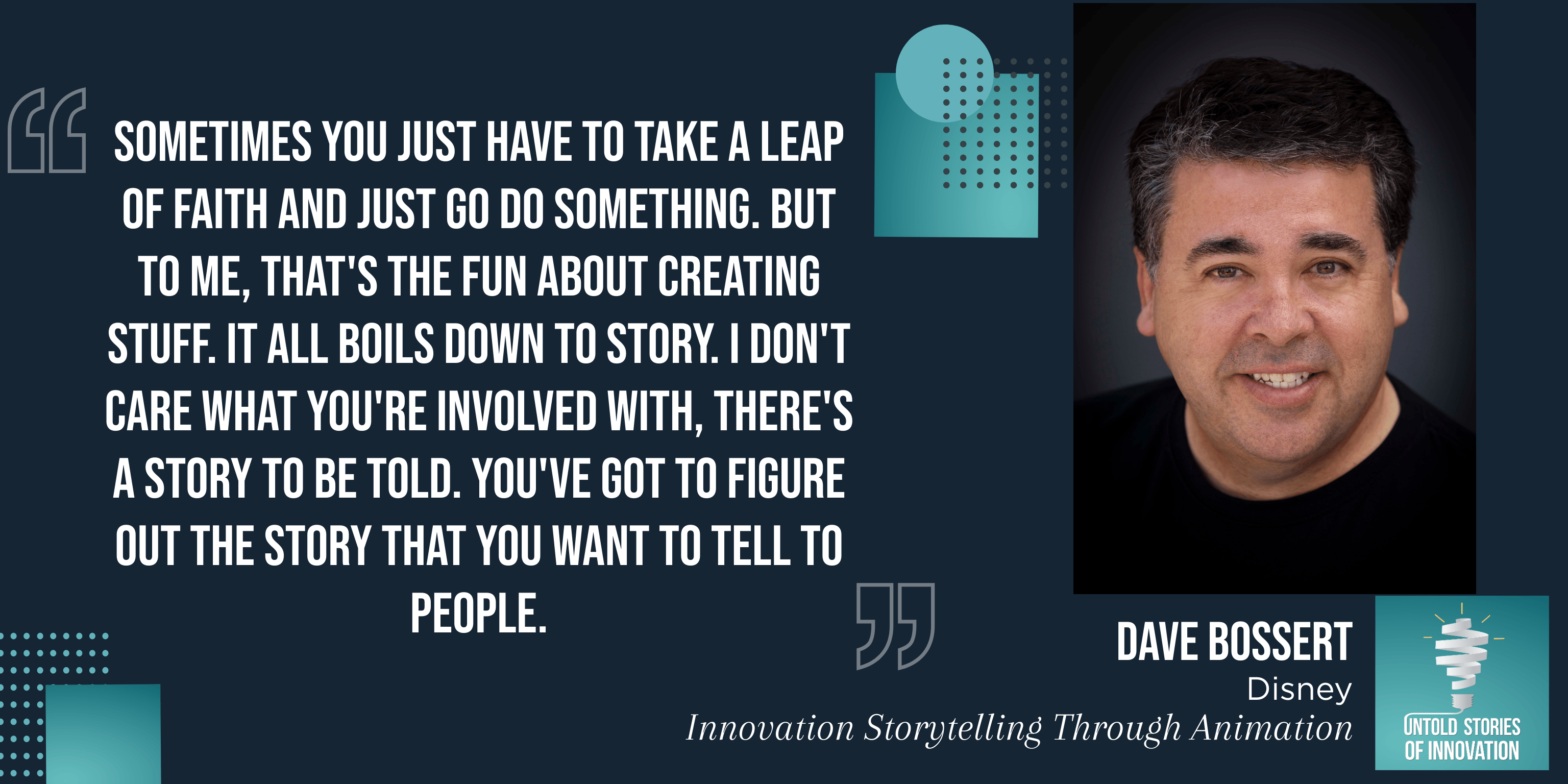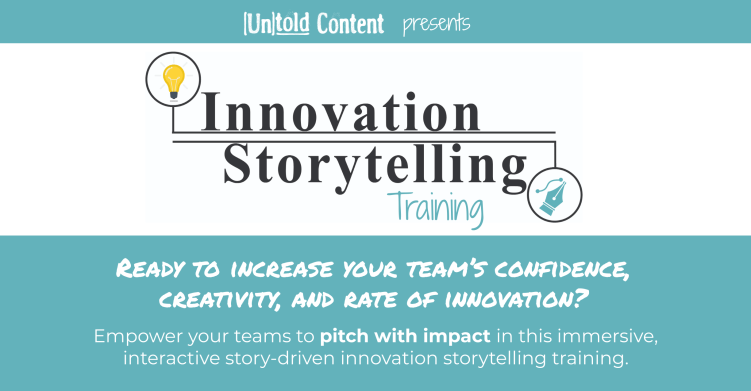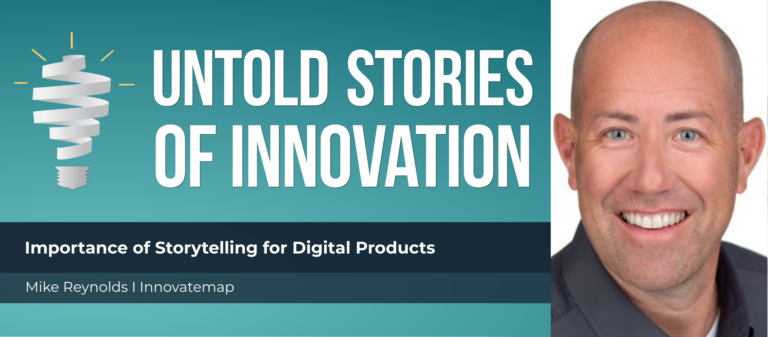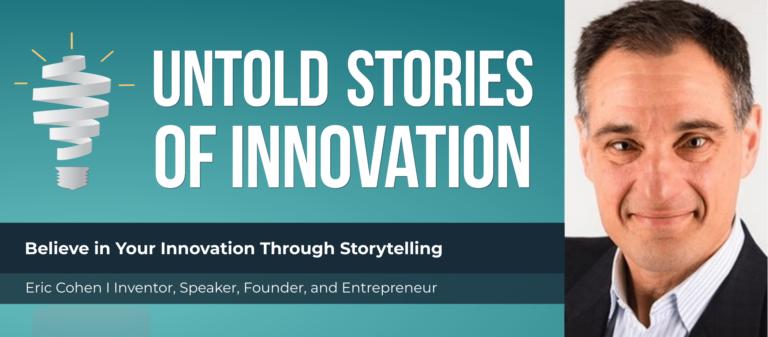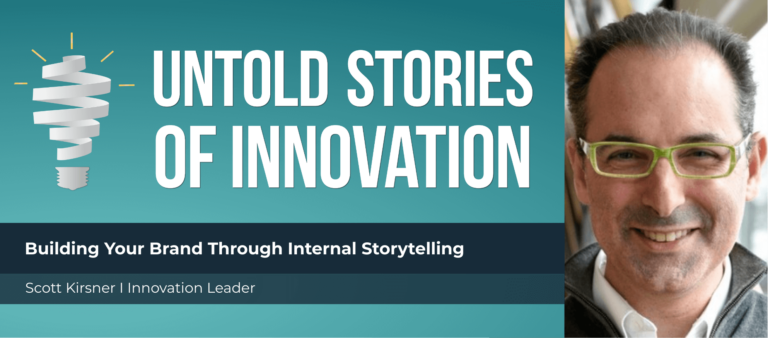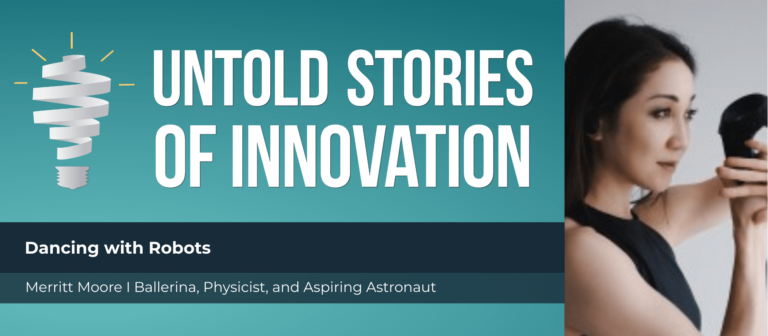Innovation Storytelling Through Animation with Dave Bossert of Disney
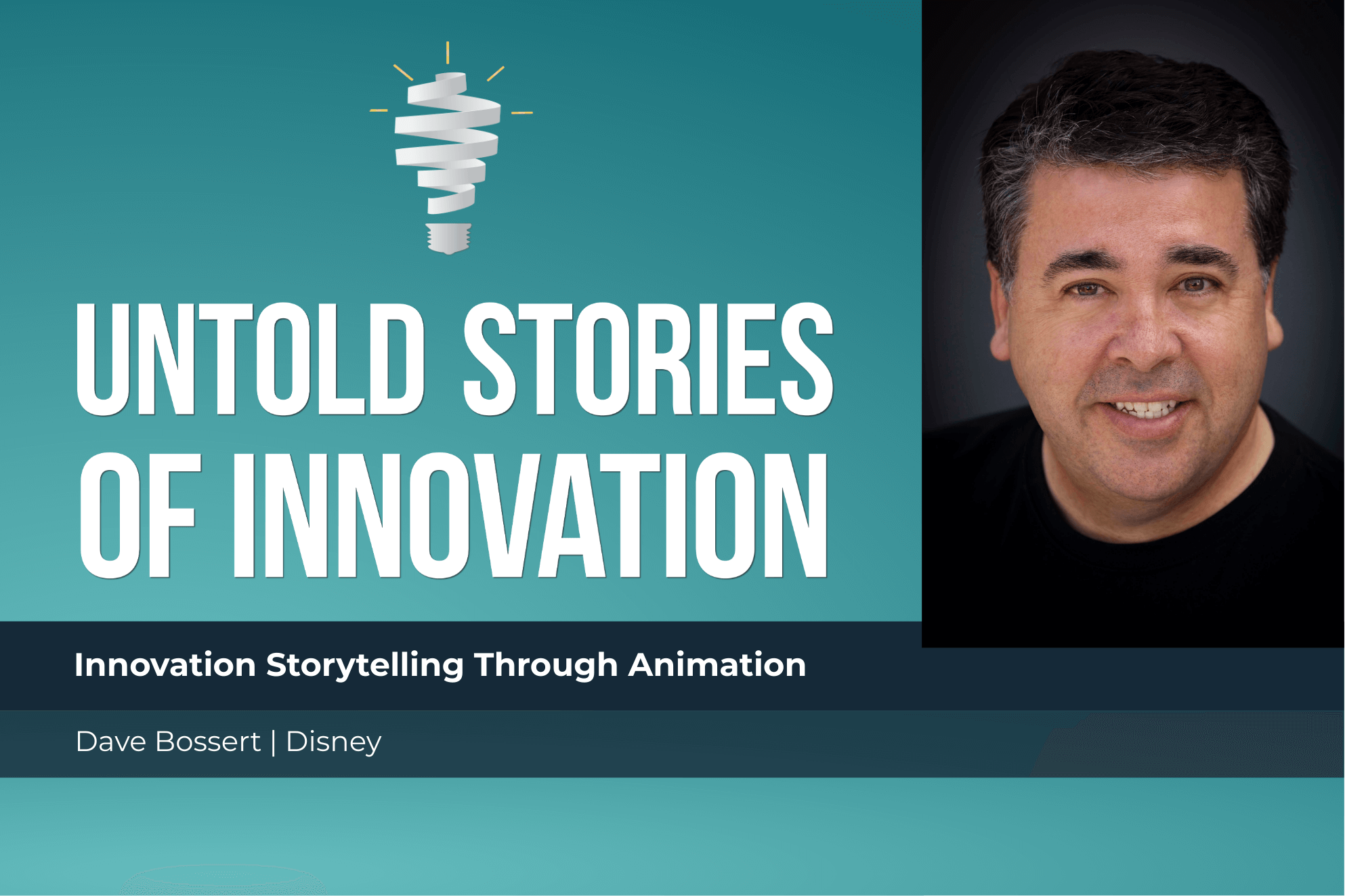
Untold Stories of Innovation
“Sometimes you just have to take a leap of faith and just go do something. But to me, that’s the fun about creating stuff. It all boils down to story. I don’t care what you’re involved with, if you’re hocking new sparkling water, there’s a story to be told. You’ve got to figure out the story that you want to tell people.” —Dave Bossert of Disney, Innovation Storytelling Through Animation
From today’s episode you’ll learn:
Why does innovation storytelling through animation matter? What values can be instilled in innovators who share stories? How do innovation leaders inspire creators to tell and share their success and failure stories?
We talk with Dave Bossert, long-time animator at Disney, who worked on iconic films such as The Little Mermaid, Beauty and the Beast, The Lion King, and The Nightmare Before Christmas. He shares with us the power of animation to convey and evoke emotion, as well as the power of emotion to impact audiences and us as innovators. We get a closer look at how his writing, producing, and filmmaking exemplifies strategic storytelling. Listen in to hear his innovation storytelling through animation story, from traveling across the country with $34 dollars in his pocket, to finding opportunity to create with the world’s most premier storytelling company.
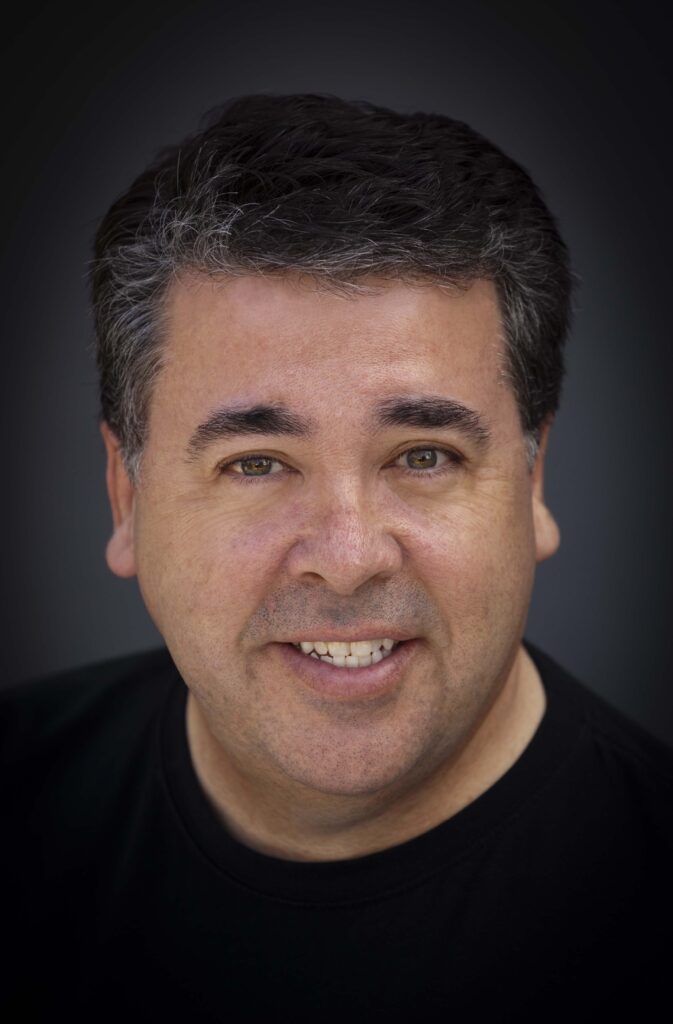
David A. Bossert is an award-winning artist, filmmaker, and author. He is a 32-year veteran of The Walt Disney Company where he contributed his talents to Who Framed Roger Rabbit (1988), The Little Mermaid (1989), Beauty and the Beast (1991), Aladdin (1992), Tim Burton’s The Nightmare Before Christmas (1993), The Lion King (1994), Fantasia/2000 (1999) among many others. Bossert is an independent producer, creative director, and writer who is considered an authority on Disney art and animation history. Bossert is the author of numerous books and dozens of articles on animation. His latest books are, Kem Weber: The Mid-Century Furniture Designs for the Disney Studios (The Old Mill Press, 2018) and Tim Burton’s The Nightmare Before Christmas: Visual Companion (Disney Editions, 2021). Learn more at www.davidbossert.com
This episode is powered by Untold Content’s innovation storytelling training. Increase buy in for your best ideas in this immersive and interactive, story-driven experience. Where your teams refine storytelling techniques for their latest projects, prototypes and pitches—and get inspired by 25 epic examples of impactful innovation stories. Learn more at untoldcontent.com/trainings/innovation-storytelling-training-for-individuals.

Katie Trauth Taylor [00:00:04] Welcome to Untold Stories of Innovation, where we amplify untold stories of insight, impact and innovation powered by untold content. I’m your host, Katie Taylor. Our guest today is Dave Bossert, he is an award winning producer, creative director and writer. He’s the former producer, creative director and head of Walt Disney Animation Studios Classic Projects. Dave, I’m so grateful to have you on the podcast today. You’ve created some pieces of art and work that has completely transformed my life. And I know so many of our listeners are thrilled to get to get inside your brain a little bit and learn about your unique take on innovation and storytelling.
Dave Bossert [00:00:51] Well, it’s a pleasure to be here with you. And I’m happy to talk about anything and everything that might be of interest.
Katie Trauth Taylor [00:01:01] It’s all of the interest, but I think I especially want to know what made you become an animator, what sort of brought you to that and special effects? Well, you know, it’s interesting.
How Dave Got Into Animation
Dave Bossert [00:01:12] I think that people when you’re growing up, you know, kids are always like, oh, I want to be this or I want to be that. And the reality is, I don’t think any of us really know what we’re going to turn out to be that young. You know, some kids will want to be firemen or policemen or my brother was hell-bent on wanting to become a pilot and an astronaut. And sometimes you follow through on those things for me. I enjoyed art. And by the time I got into high school, I really focused on developing some artistic skills. And I was fortunate to have a really great high school art teacher, which I think today is kind of in short supply. And I think when school districts cut their budgets, they usually go for the arts first. Yeah, but when I was in high school, I had this really great classically trained art teacher. He was an accomplished artist himself and he really encouraged me. And I really look back on that as being one of those people that really sort of pointed me in a direction. And when I got out of high school, I enrolled in an advertising art program at a local college in New York. And while I was there, I took a class that was called TV Graphics. Now, this is pre-computer days. But it was the first time I actually created a piece of animation with my artwork where I took a piece of artwork and I created motion with it.
Katie Trauth Taylor [00:03:02] And what was it like?
Dave Bossert [00:03:04] It was actually kind of cool. You know, you get that big smile across your face and you’re like, wow, this is awesome. And you start thinking of the possibilities. And right about that time, a friend had passed off an article to me from The New York Times that was about a school in Los Angeles that was training the next generation of animators for Disney. And I promptly packed up my portfolio and shipped it UPS out to the school to apply. And they only accepted 30 students a year into that program.
Katie Trauth Taylor [00:03:50] Wow.
Dave Bossert [00:03:51] And I thought, well, you’ll never know unless you try. So I was thrilled when I got accepted to the program. And I also received a Disney scholarship and. I packed up a Volkswagen Beetle I had and I drove cross-country and I arrived in Los Angeles and I remember this clearly, I literally arrived in Los Angeles with about thirty-four dollars in my pocket.
Katie Trauth Taylor [00:04:21] Wow.
Dave Bossert [00:04:22] I know it’s crazy. But I wound up going through the program at CalArts. It was called Californians to the Arts. And a lot of people didn’t graduate from the program because they were getting plucked out of the program to work at studios, notably Disney. And when I graduated, I wound up getting hired at a small studio in Studio City, California. And I worked there for about nine or 10 months on some very early video games. One was called Space-ace, the other one was called Dragonslayer, and then the company went bankrupt. And that was kind of comical because they had this studio meeting in the parking lot. The head of the studio said, well, we just run out of money, so we’re closing the doors.
Katie Trauth Taylor [00:05:17] Oh, my goodness.
Dave Bossert [00:05:19] And I figured, well, I’ll go back to New York and I’ll get into advertising, because that’s kind of what I wanted to do was advertising. And I thought I’d be able to do animated commercials in New York City. And then a friend of mine was working over at Disney and he says, hey, you know, why don’t you send your portfolio over? Because they really need some help getting a movie finished. And so I said, well, let me do that. And I could work on a picture and then I’ll go back to New York. And so I sent my portfolio over to Disney and they hired me right away. And I started working in the special effects department on a film called The Black Cauldron and one of the lesser successful Disney animated films. But it does have a special place in my heart, because it was the first picture I ever worked on. And I was crazy because I thought, well, I’ll work on this picture and I’ll just save up as much money as I can. And I’ll head back to New York. And I did a lot of overtime and all I was doing was like I started my first week there. I worked six days, I worked Saturday. And then after five months, I started working seven days a week to get that picture finished and just was making tons of money because I was getting paid overtime and golden time and all this stuff. And I didn’t have any time to spend the money. I was just putting it all in the bank. And I figured by the time that picture was getting finished, I’d get laid off and maybe spend a month on the beach figuring out what I wanted to do and then go back to New York. And and so towards the end of that picture, they actually started laying people off. And I saw people I’d be working with who had been there for years. I was the last guy hired into the department. So I thought, well, I’ll be the first guy left out. And they’re letting all these people go around me. And finally, it was May of nineteen eighty five. And I was working on one of the last special effects scenes in the picture, and I finally went down the hall to the production manager and I said, “Hey, you know Don,” who’s a friend of mine now, I said, “”Don, can you give me a sense of when you’re going to lay me off so I could just kind of plan ahead?” And he looked up at me and he said, “Dave, we’re not going to lay you off.” He goes, “You’ve been working so hard, we’re keeping you.” And. And I think my jaw hit the floor and my eyes became saucers. And I was so surprised. And I said, well, can I at least take a couple of weeks off to rest while working so hard. And so I wanted to take it a little bit of a vacation. But that was kind of how I wound up getting in there and I thought I literally thought for the next, like, five pictures. I worked on that at the end of each one. I was just at the end of this picture, I’ll get laid off and I and like all of a sudden, like thirty two years later, I was like, wow, know? I mean, you look back and you go, what a career.
Katie Trauth Taylor [00:08:45] Oh, my goodness. And for those of you who maybe don’t know, we’re talking the types of pictures you got to work on, that you played an integral role in The Little Mermaid, who framed Roger Rabbit, the rescuers down Under Beauty and the Beast, Aladdin and the Lion King, Pocahontas, Hunchback of Notre Dame, Hercules, every single one. It feels like these treasured what are now classics, who we pass on to our children and our grandchildren. What an incredible career.
Dave Bossert, Disney Animation, and Innovation Storytelling
Dave Bossert [00:09:14] innovation storytelling through animation Yeah, it was really a lot of fun. And when you’re working on pictures like that, you don’t you don’t really know what it’s going to be like. I mean, you’re enjoying yourself. You’re creating art. You’re working with hundreds of other artists to create these animated pictures and you’re not sure how they’ll be received when they go out. And it’s certainly gratifying, obviously, when you work on a picture that becomes really almost an instant classic, the way Beauty and the Beast did. In fact, the interesting thing about Beauty and the Beast was that when it was released to the theaters, we started getting all these reports at the studio that the theaters were selling our evening shows that they were like it was becoming a date movie. And that was really kind of incredible. I thought, you know, absolutely.
Katie Trauth Taylor [00:10:09] Yeah, it still is. I think it still is.
Dave Bossert [00:10:12] Yeah. I mean, it’s pretty amazing.
Katie Trauth Taylor [00:10:15] But that image of you working on your first film and the amount of perspiration required, we were talking a little bit before the podcast about Thomas Edison and how he once said that genius is one percent inspiration and ninety nine percent perspiration. And for so many people, the work of artists, animators like yourself, we look to you to inspire us. And so could you talk a little bit about bringing ideas to life through animations and how, you know, for us we only see that one percent of what really goes into these storylines that we fall in love with?
Dave Bossert [00:10:56] Well, you know, I mean, to me and this really, I think applies to anything to do with the art of creating something, whether you’re creating a painting or writing a book or creating a piece of music, it really starts in your head. And when I was animating at the studio, I’d get a scene and I’d go over the scene with the effects supervisor and usually the director to get a sense of what it was that they were looking for. Some scenes were straightforward and you knew exactly what you needed to do. But in other scenes, you really needed to kind of get into the head of the director, the storyteller of that picture and understand what they were looking for. And you had to be aware of where your work fit into the whole of the picture and with special effects. For the most part, special effects are like a supporting character to the actual characters in the film. And oftentimes in a picture, the special effects become the dominant feature. There’s some sort of climactic, spectacular thing where it requires a lot of special effects work to really help tell that story point convincingly. And so for me, after. We are talking with the director of the effects supervisor, I oftentimes went back to my office and sat in a chair and and just literally close my eyes and started thinking about that scene until I was able to actually visualize it and visualize exactly how I was going to approach it and how I was going to draw that scene. And that’s really what I often do even today, whether if I do a sculpture or I’m in the midst of writing another book, my mind is constantly working and thinking about that. And then at some point it comes out of your hands and you create. And that’s really how I look at it.
Katie Trauth Taylor [00:13:16] innovation storytelling through animation I love that image of you taking that moment to close your eyes. It sounds like the inspiration sort of happens in those small, more quiet moments for you.
Dave Bossert [00:13:26] Yeah. And, you know, the funny thing is, the managers and bean counters often thought you were goofing off and wasting time. And to me, it really was a major part of what you were going to create. You had to sit and just really sort of think about it and and really sort of block everything else out and focus your mind on that one thing. What was that going to look like? How were you going to start that? How are you going to choreograph the animation for that scene and the hugely, hugely important.
Katie Trauth Taylor [00:14:13] You know, I’m thinking of the the time that many companies now are giving to their employees to just be free, Google giving, I think it’s 20 percent of employee’s time and saying you have to spend 20 percent of your workweek not working and then apply that that thinking. Those are the insights you uncover during that time to the rest of your work. I guess one question I have is, did you ever feel guilty about making that time to just sit and be quiet? Or did you feel a lot of pressure from the outside to look productive in those times that you knew productivity was happening? But maybe earlier in your career, did you feel guilty or worried that you didn’t seem as though you were making things happen in those moments?
Dave Bossert [00:14:59] No, I never really felt that guilty about it. I probably early on, I didn’t really have that much time to sit around and do that, because when you enter into whatever business it is. But when I entered Disney, I entered at a low level position. So I was called in between or so I was filling in, drawing. So essentially the vision of the scene had already been worked out by the animator. And, you know, the assistant brought it to a certain point. And then it came down to me where I filled in additional drawings so there wasn’t as much in the way of having to think about what it was going to be. But as I progressed through the ranks and became an animator and a supervising animator and the visual effects supervisor know those are the places where you start to take that time to sit down and just really visualize what it is you’re going to do. And each artist has their own process, their own way of doing that. Some people will sit and just start drawing and some nailing stuff out. Other people are going to sit for a little bit, maybe a couple of hours or a half a day and just think about things and companies today that are giving their employees that time to take for themselves whatever job you’re doing. You’re never really not doing it because you’re thinking about it either on a conscious or a subconscious level. Your mind is always going and you’re always thinking whether you’re writing code for something, which to me is a very creative process. But people have to think about that. So driving to work, driving home from work while you’re sleeping, your mind is still working and still processing what it is that you’re doing or going to do.
Katie Trauth Taylor [00:17:11] innovation storytelling through animation That’s so true. Yes, absolutely. And that really accepting where creativity lives for us on an individual level, I think is really powerful advice that you’re speaking to. You know, for most of the innovation leaders that we’re interviewing on this podcast, we asked them what role storytelling plays in the art of innovation. But I kind of want to reverse engineer the question for you and ask what role does innovation play in the art of storytelling?
Dave Bossert [00:17:41] Well, you know, to me, I think that anything that you’re going to work on and I have some good examples of this, and maybe I’ll just jump in and tell you, like, just the simple act of writing a book drove me to invent something that didn’t exist. And so it was I was writing the book on Dolly and Disney decided, and it was a collaboration in nineteen forty six between Salvador Dali and Walt Disney on a short film that was going to go into a Fantasia like movie. And as I was writing that book, I kept thinking to myself, I want people to see that short film, because even though Dolly and Disney didn’t finish the film in nineteen forty six, I was part of a team that finished the film in two thousand three. And so we have this wonderful six minute short film. And as I was writing the story about that collaboration between these two. 20TH century artists, these two titans of the art world, I kept thinking to myself in the back of my mind, I wanted people to be able to see the movie and why couldn’t we put the movie into the book? And so to me, I just kept thinking about that. And I sought out a person who was working over an Imagineering at Disney that was an expert in display technology. And I introduced myself to him and we got together for a coffee and we told them what I wanted to do. And we wound up building a prototype. I took it. I took a book and I cut out some of the pages up front and we put a screen in and we embedded the movie on a chip and had a play. But then everything. And I shot a little less than a minute teaser on my iPhone. And I and I emailed it to the publishing people that were publishing my book. And I said, I think we should do this maybe as a special edition or something like that. And I got a call like in five minutes after I sent that and they flipped out, they couldn’t believe it. They had never seen anything like that before. And we wound up putting it together. And it took about two years to get it to market because it had never been done before. And there are things like the spine of the book had to be a quarter inch taller than the thickness of all the paper that went in the book to accommodate the thickness of this seven inch, high def screen that we put in and the electronics and the flat battery and all of these things. And we wound up putting it all together. And it was to me, I get the most joy when I go out to speak about this, because I usually bring a copy of that book and I will stick my finger up inside the cover and press the button. And I hold the book up and then I open it and they see the movie playing on a screen. And there is this oh oh that goes across the audience, you know, one hundred, one hundred fifty people that you’re talking to and they all go, Oh, I’ve never seen that before and I get such a charge out of that. But to me my thinking process is that no matter what you’re doing, how can you wow people or entertain somebody or do something different that people haven’t seen before? And that was the case of taking existing technology and merging it into a book and being able to do that again. I think if I hadn’t built the prototype of it and I just explained it to somebody at publishing, they would have patted me on the head and said, “Oh, that’s nice, Dave. Now go back to work and finish that book.” Sometimes you just have to take a leap of faith and just go do something. But to me, that’s the fun about creating stuff. And it all boils down to story. And I don’t care what you’re involved with, if you’re hocking new sparkling water, there’s a story to be told, you know, and you’ve got to figure out what is that story that you want to tell to people. Obviously, when I write books, one of the best compliments I get from people is I felt like you were sitting next to me telling me the story.
Katie Trauth Taylor [00:23:03] Yes, absolutely.
Animation, Storytelling, and Creativity
Dave Bossert [00:23:05] And that’s that that to me is the best compliment I can get from somebody when they read one of my books is for them to say that to me, because that to me is what it’s all about. You’re telling stories. And again, I think this touches people. No matter what you’re doing in your life, you could be working. You could have a fast-food restaurant. What is the story you’re telling about that fast food restaurant? You know, everything has a story around that.
Katie Trauth Taylor [00:23:38] innovation storytelling through animation Yes. Totally agree. When you’re thinking about when you’re sort of stepping into a new project, whether that’s a book or another picture, you know, what do you sort of envision as your key hope when it comes to audience engagement? What’s your vision when you step in?
Dave Bossert [00:23:56] Well, obviously, with anything you do, you know, you’d like people to be able to enjoy it. You know, I’m in the last couple of years, I’ve been writing full time and I’ve put out a number of books. And so for me, the hope is, is that I’ll get a comment from somebody who says, I read your latest book and I really enjoyed it. I put out a book about a year, a little over a year ago about the animation furniture that I worked on at the studio.
Katie Trauth Taylor [00:24:30] Yes. I guess and I looked into that, it was so interesting.
Dave Bossert [00:24:37] innovation storytelling through animation When I left Disney, I had been working on one of these Ken Weber desks that was built in nineteen thirty nine. And when I was leaving they said, Would you like your desk? And I was like, wow, absolutely. And I’m actually sitting at this. Nineteen thirty nine Ken Weber animation desk talking to you and this is where I write my books now. And I was sitting here working on a book that’s coming out next year, and I kind of sat back as I was typing one day and I started just kind of looking at the desk and you have flashbacks of memories from different pictures you worked on and stuff like that. But I was sitting here looking at the desk, as I’m doing right now, as I tell you this story. And I thought, I wonder if anybody’s written anything about this furniture, because this was specialized furniture that was created for the animation process at the Walt Disney Studios. And I wonder if anybody has documented this. And so, you know, I wound up blowing the afternoon doing research on that instead of writing the book that I was working on. And it turned out there really was no documentation on it. And I decided this would make a great book. I want to do this book. And then I was met with the from the publishers. Well, it’s kind of a niche topic, Dave. You know, who’s really going to buy this book? You know, we don’t see they didn’t see it as something that they could sell twenty five thousand copies of. And so everybody passed on it and then I still decided, well, I’m going to go do this book anyway because I want to do it. It was an image to the furniture I had worked on for thirty two years at the studio that I’m still working on today, that I felt like this furniture had a soul to it and there was a story to be told. And so I just went ahead and did it. And I found Cambers archives up in Santa Barbara, found a lot of great material there and images of a lot of his artwork and early designs and all of that. And I did the book and I published it. Yeah.
Dave Bossert [00:27:13] And the book is gone out and it’s been really well received and it’s won a bunch of awards, which is crazy.
Katie Trauth Taylor [00:27:22] innovation storytelling through animation When you think about there’s so much conversation, even just in the innovation community around or in the business community around what configuration will lead to the most collaboration or creativity or, you know, how space and impacts the work that we do and our productivity, our relationships, our motivation. It’s so built into every aspect of how we work. And looking at a piece of furniture like your desk in the way that it was designed to facilitate creativity in the animation work and to enable you to work in a way that was different, to produce a product that was different from any other that had ever been created before. I get it. I think that it is something that can be of interest to people across their different business or personal interests. It’s fascinating.
Dave Bossert [00:28:18] Yeah. And so, you know, I have the luxury now to just decide, oh, I’m going to go do that and just do it. And so I think that’s kind of a fun thing. I also think it’s a very important thing because oftentimes people will say, I’m going to do that, or I wish I could do that, or someday I’m going to do X and then they never do. And for me, when I decide, oh, I’m going to do something like put a video screen in a book or write a book on furniture and know anything like that, I go ahead and follow through on it. I just do it. And I think that’s a hugely important thing. However crazy some of the ideas that we need to come up with, there’s validity to them and there are things that you should go and try and, you know, and maybe it won’t work out, but maybe it’ll lead you to something else. And I think that’s, you know, that’s the fun of it. You know, that discovery.
Katie Trauth Taylor [00:29:30] Yeah, absolutely. And I’m wondering, too, would you speak to the power that animation has to create new worlds to really, really in some ways, when when you’re facing the opportunity to create an animated story, you at least from an outsider’s perspective, it seems as though you have hardly any limitations. You could be in outer space and gamma quadrant 10, you could be under the water. You can have characters that aren’t human. You can really everything that defines reality for most people can get completely turned on its head inside the world of animation. So how do you innovate when you have no limitations?
Dave Bossert [00:30:16] Well, I think that most people put constraints on themselves. I think people, you know, immediately it’s almost like people are conditioned to say now that that as you grow up, you know, I want to go do this. No, you can’t do that or you can’t do it that way. You need to do it this way. This is the way we’re teaching you how to do something. And I think there’s a natural tendency for people to jump to know. I used to have fun at the studio because I made it a point to try and turn a no into a yes. I did it and I was able to do it most of the time.
Katie Trauth Taylor [00:31:03] Can you give me some examples?
Dave Bossert [00:31:04] Well, it was just sort of like I’d like to go and make a documentary while I’m working on a project that is requiring me to do a lot of scoring sessions. I’d like to do a documentary about music and animation. And it was sort of met with a why do you want to do that? And I was like, well, because it hadn’t really been covered, it hasn’t been documented. And because I’m doing the scoring sessions, it would be easy for me to just film some of this stuff and then interview composers and things like that. Well, I don’t know if I’m not sure. And then I go back and say, look, I’ve already paid for the scoring session for this project. We’re doing it at Capitol Records. We’re in a historic recording studio stage at Capitol Records. I really want to film some of this stuff. And then finally, it was like, well, what are you going to do with it? Well, it’ll be educational. It’ll give some insight into how we do things and to go into film festivals and blah, blah. OK, we’ll go ahead and do it.
Katie Trauth Taylor [00:32:22] A passion for playing a big role. Yeah, absolutely.
Dave Bossert [00:32:27] You know, and so I tend to approach things that way and think beyond whatever it is that I’m doing. You know, how can I you know, I’ve been giving lots of thought about writing books. And when I did that Ken Webber book on furniture, I really felt like I needed to elevate the book itself to a piece of art. And so I was very much involved with talking to the printer and picking out a heavier matte finish paper stock and all the images that went in the book. I wanted to put spot varnish on and I really wanted the book to have, like when people felt that there was a tactile experience to it. And I have a number of people say to me that the book itself was a work of art because of the printing techniques that we use. And it was very collaborative because I was talking to the printer and saying, what are some of the cool things that we can do? And he would be showing me samples of stuff. And, you know, we decided to put some wood texture on to the cover of the book. So when you first pick up the book, you feel you can feel the wood grain on the cover of the book. And that was sort of just high concept-wise, bringing you into this world of this wood furniture that was built for the Disney Studios. And that’s kind of how my mind works when I’m dealing with these types of projects. How do you do something different that hasn’t been done before so that what you’re working on isn’t just the run of the mill? You know?
History, Storytelling, and Animation with Dave Bossert
Katie Trauth Taylor [00:34:37] Absolutely. I love getting lost on your website, actually. And I highly recommend this to people listening to it to hop over to davidbossert.com and especially check out some of the articles and essays. And obviously your books are incredible. And these articles fascinate you clearly, have a passion for history and sort of uncovering lost stories. And one of the ones I read was about the Mickey Mouse gas mask.
Dave Bossert [00:35:06] Oh, yeah. Yeah. That I am actually at a future date. I’m taking all of those essays that I’ve written after World War Two, and they’re all going into a book with expanded information and more images and stuff like that. But this is a passion of mine, too, and more so today, because there’s such division in this country and really around the world. It seems that, you know, that that the people are so divided and angry and, you know, the political situation is just so unfriendly. And I’m so fascinated by that period in World War Two, because it’s dubbed The Greatest Generation. And it was a period when everybody pulled together. Everybody, you know, everybody just whether you went into the military and served or you stayed at home and served your country by working in the factories to churn out planes and tanks and whatnot. Everybody just seemed to come together during that period and the Disney studio was no different. They were part of that. They contributed greatly, creating training films and all kinds of things, you know, and when the government came knocking, they answered the call. And there’s just such wonderful warmth about that period, even though it’s part of a horrific world war, you know. And so finding all those individual stories like the Mickey Mouse gas mask and how that came about and what the thinking was and the fact that the British were telling children with their gas masks that it was Mickey Mouse, even though it wasn’t they were using that term to try and soften it and quell the nerves of the children when they were going into air raid shelters.
Katie Trauth Taylor [00:37:30] Yes. So then and then at that point, Walt Disney Company embraced it and said, you know what? Let’s make a real Mickey Mouse. Exactly. Yeah, exactly. Alleviate their fears. It’s really. Yeah, it’s an incredible story. I love your writing.
Dave Bossert [00:37:44] Thank you very much. In fact, they made a tin for the British that had the Mickey Mouse characters on the tin for the kids to put their gas mask in. It was like their own little holder for it, for the gas mask. And so you take, you know, these horrible things that are going on in daily life and you’re actually trying to soften them a little bit, you know, and put people at ease. And I just thought there’s a lot of those kinds of stories to be told that nobody really has delved into and talked that much about. And so for me, those things are fascinating. I think that they are pieces of history that you want to document.
Katie Trauth Taylor [00:38:37] Yeah.
Dave Bossert [00:38:38] So that they don’t get lost to time like so much stuff has.
Katie Trauth Taylor [00:38:42] And I think by sharing those moments of innovation and creativity and our history and inspires us to think that way today and think how on earth or why would we, you know, create a gas mask with Mickey Mouse face. Right. But when you look back and you see that moment in the context and the history, it’s clear that thinking outside the box and really trying to do something bigger sometimes takes that level of creativity. So, yeah, I think it’s inspiring. And it reminds us to think in a collaborative way and to perhaps embrace things that may, on the surface seem, you know, impossible or strange. And, gosh, isn’t that part of the entire history of Disney and the films that have come out even since then?
Dave Bossert [00:39:33] Well, you know, the amazing thing is, is that when I worked on those pictures, especially in the period that they now referred to as the renaissance of animation, which is the nineteen eighties, nineteen nineties, you realize when you’re working on stuff that. What you’re doing, regardless of what you’re doing, it’s going to touch somebody in some way, maybe, maybe in a little way or maybe in a very profound way. I remember when we worked on The Lion King there after it was released to theaters, the studio received some letters and one in particular really stands out to me. And I sometimes get choked up when I talk about it. But it was from a woman who lost her husband, the father of her son, and the Lion King, because Simba loses his father in the film that so touched them because of their loss. And it helped. She wrote that it helped her son get through that difficult period. Oh, sure. To understand the circle of life and the fact that he needed to go on and continue on and his father would always be with him, you know.
Katie Trauth Taylor [00:41:09] Yes. Yeah, absolutely. I think that there’s such a responsibility for our world’s greatest storytellers to meet us where we’re at. And that’s the genius of the films that you’ve worked on and the ones that keep continuing to come out that way that we can relate and really put our lives in the context of these bigger stories.
Dave Bossert [00:41:36] You and that’s so true. And that’s true of the entire film industry, not just the animation, that film in general. It draws us in. It entertains us and makes us laugh. It makes us cry. It makes us think about things deeper. And I think that’s one of the things I’ve always loved about film entertainment and why certain movies I can watch over and over and over again because they just resonate with me.
Katie Trauth Taylor [00:42:11] Yeah, for sure. You know, if you were to give advice to people who are wanting to be innovative or who are leading innovation teams, whether that’s, you know, and really across all industries and all ages and all talent areas, what would what advice would you give, especially sort of pulling from the lessons you’ve learned as an animator and special effects artist?
Dave Bossert [00:42:38] Well, I think that there is a lot of validity to just sort of that blue sky process of throwing stuff against the wall to see what sticks. And one of the things we used to do oftentimes at the beginning of pictures is just that we just start throwing ideas out. And how ridiculous an idea might be my maybe enough to spark a colleague to say, yeah, but you know what? What about this? And that leads you down this path of, you know, what could we do? What can this be? What could that be? And but at the end of the day, these films that we worked on, it was all about having a really strong story. With endearing characters set in a world that we’d want to visit multiple times, that we’d want to keep coming back to, and that’s really what it’s all about, you have to start with the story and expand from there.
Katie Trauth Taylor [00:43:45] Yeah, definitely. That is a beautiful image. And I love that idea of being bold and taking risks in order to not only just have that idea be the winner, but in order to let that be the assistant to another team member who might be able to rein it in or reapply or build upon it to get everyone moving in the direction it’s meant to go. Absolutely.
Dave Bossert [00:44:11] You know, it’s just to me, it’s an extremely fun process and it’s one that has to be allowed to take its course. Again, I talk about throwing ideas against the wall to see what sticks. But that to me is a big part of the creative process is to, you know, to push yourself to think outside the norm, outside the box and to push the envelope. And again, it’s so true for whatever business you’re in. It’s not just related to the film business or the animation business or music. You can put this thinking into place out in the world anywhere.
Katie Trauth Taylor [00:45:07] Yeah, I completely agree. One hundred percent. So Dave, I’m so grateful that you made the time today to talk with us about creativity and invention and persistence. And you can follow David on social media at @Dave_Bossert and check out his website, David Bossert, read his books. And I’m so grateful for all the insights you shared today.
Dave Bossert [00:45:32] It was absolutely my pleasure. I really enjoyed talking with you and I hope I hope what I had to say, uh, may resonate with somebody out there in the world, I’m sure.
Katie Trauth Taylor [00:45:44] Yes, it definitely will. Thank you so much, Dave.
Dave Bossert [00:45:49] My pleasure. Thank you.
Katie Trauth Taylor [00:45:52] Thanks for listening to this week’s episode. Be sure to follow us on social media and add your voice to the conversation. You can find us at untold content.
You can listen to more episodes of Untold Stories of Innovation Podcast.
*Interviews are not endorsements of individuals or businesses.
